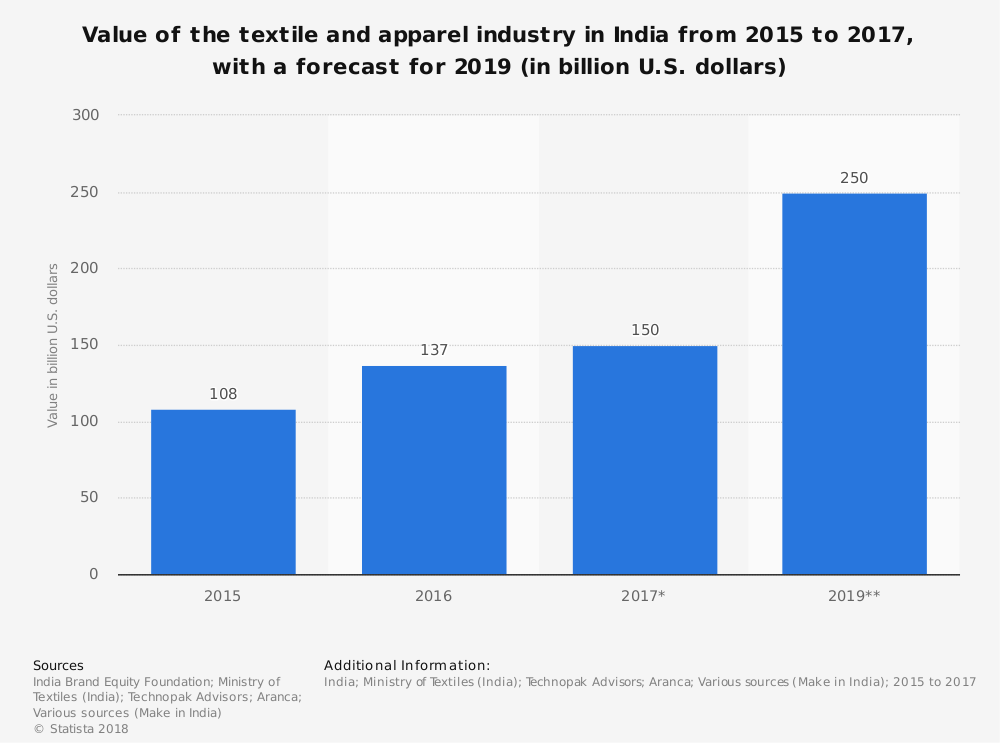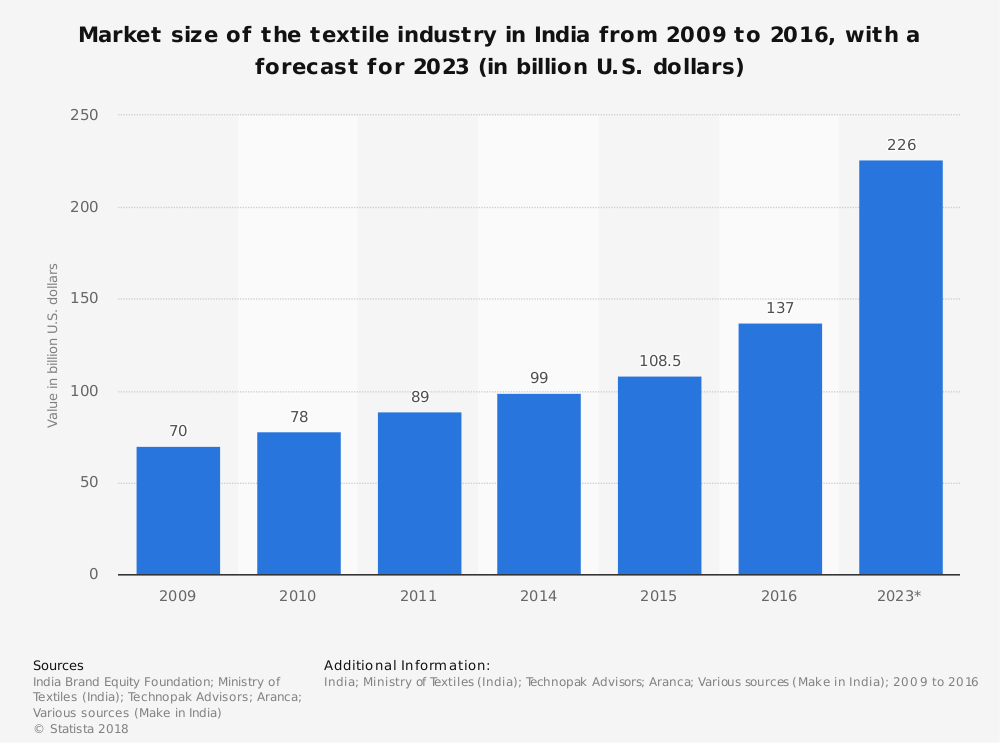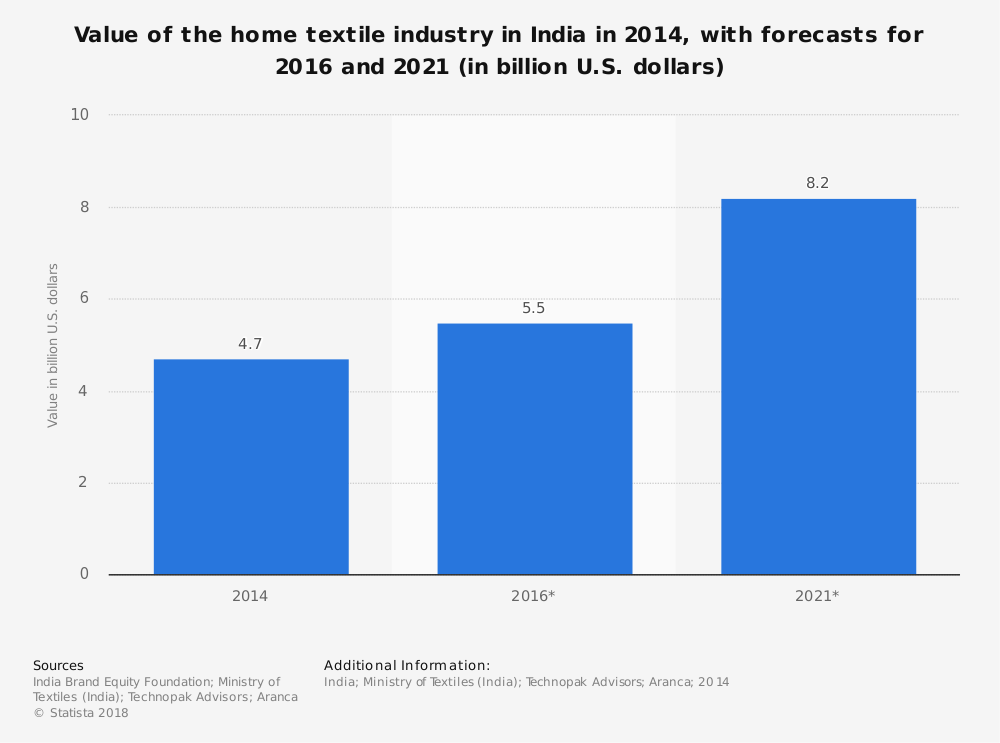Textiles are an important component of the Indian economy. In the state of West Bengal, there is a focus on five specific segments of the industry’s value chain. One of the most important areas for the state is textiles machinery, as the overall Indian textile industry imports almost all of the equipment that it needs.
The other segments of focus for the West Bengal textile industry are linens, workwear, technical textiles, and innerwear.
There are numerous advantages to the development of the textile sector in West Bengal. Not only are the weather conditions well-suited to the agricultural side of the textile chain, the availability of power and labor is excellent as well. The infrastructure in West Bengal is already capable of supporting the import/export needs of the industry as well.
This is why 47 new textile units have been set up with capital investments in the state since 2010.
Important West Bengal Textile Industry Statistics
#1. India is the second largest producer of silk in the world. About 95% of the world’s handwoven fabric comes from India. (WEST BENGAL INDUSTRIAL DEVELOPMENT CORPORATION)
#2. The overall textiles industry in India contributes to about 14% of the overall industrial production in the country. This equates to about 4% of the GDP in any given year. (WEST BENGAL INDUSTRIAL DEVELOPMENT CORPORATION)

#3. Outside of the agricultural sector in India, the textile sector is the largest employer in the country. About 1 million people have direct employment over the course of a year because of the industry. (WEST BENGAL INDUSTRIAL DEVELOPMENT CORPORATION)
#4. Production of cotton yarn has increased by 5.6% in year-over-year data, while the production of cotton cloth has increased by 8.7%. (WEST BENGAL INDUSTRIAL DEVELOPMENT CORPORATION)
#5. More than 300,000 handlooms are currently operating in the West Bengal textile industry right now. Those handlooms provide direct employment for over 660,000 people, according to data released in 2010. (WEST BENGAL INDUSTRIAL DEVELOPMENT CORPORATION)
#6. There are over 10,000 powerlooms in West Bengal that provide employment for another 221,000 people. (WEST BENGAL INDUSTRIAL DEVELOPMENT CORPORATION)
#7. More than 120 million square meters of cloth was produced on the powerlooms alone in the fiscal year that ended in 2010. (WEST BENGAL INDUSTRIAL DEVELOPMENT CORPORATION)
#8. Sericulture opportunities in West Bengal provide opportunities for over 100,000 families who live in rural or semi-urban areas. (WEST BENGAL INDUSTRIAL DEVELOPMENT CORPORATION)
#9. More than 176 million kilograms of hosiery cloth was produced by the West Bengal textile industry during the fiscal year that ended in 2010. (WEST BENGAL INDUSTRIAL DEVELOPMENT CORPORATION)
#10. The Indian textile industry has a total of 83 composite Jute mills that are in operation. 64 of those mills are located within West Bengal. A large majority of the mills in West Bengal are congregated around Kolkata. (WEST BENGAL INDUSTRIAL DEVELOPMENT CORPORATION)

#11. Branded products that are manufactured and marketed represented about one-third of the total textile companies that currently operate in and around Kolkata. (Maps of India)
#12. More than 20% of Kolkata’s textile houses have a minimum of two manufacturing facilities that are in operation. (Maps of India)
#13. Nearly 40% of the textile companies that are part of the West Bengal textile industry have more than 20 years of operational experience within the region. Just 18% of the operational companies established their operations after the year 2000. (Maps of India)
#14. Two out of every three textile companies in West Bengal are involved in exporting in some way. About 40% of those involved in the export side of business represent a vast majority of the industry’s overall total revenues. (Maps of India)
#15. For the fiscal year that ended in 2017, the government allocated more than $118 million for small, medium, and micro businesses within the textile industry. (India Brand Equity Foundation)
#16. The industry is also one of the world’s leading exporters of leather products. Over 660 manufacturing units are currently operational within the state, producing about 25% of the overall tanning activity that occurs in India. (India Brand Equity Foundation)
#17. The technical textiles industry in India is growing at an annual rate of 11%. (FICCI)
#18. The total size of the textiles industry in West Bengal is estimated to be worth about $3 billion annually. At the end of the fiscal year in 2010, that accounted for about 5.2% of the total Indian textile industry. In 2001, the size of the industry was estimated at just $1.2 billion. (FICCI)
#19. West Bengal has the highest income levels per capita in East India, with the average income being $848 annually. (Frost and Sullivan)
#20. One of the industry’s biggest issues is the cash subsidy on Jute products offered by the Bangladesh government. A 7.5% cash subsidy is placed on the export of Jute bags, which makes imported bags in West Bengal cheaper than bags that are manufactured locally. (Ministry of Textiles)

#21. The readymade garments sector has over 21,000 units in operation which employ about 200,000 people every year. This segment of the local industry produces about 500 million pieces each year. (WEST BENGAL INDUSTRIAL DEVELOPMENT CORPORATION)
#22. About 18,000 hosiery units are currently operational within the West Bengal textile industry, employing about 110,000 people. (WEST BENGAL INDUSTRIAL DEVELOPMENT CORPORATION)
#23. West Bengal has the largest area of Jute production for textiles in the entire nation of India. Over 500,000 hectares are currently reserved for production, with over 7.2 million 180kg bales produced annually. (WEST BENGAL INDUSTRIAL DEVELOPMENT CORPORATION)
#24. Despite the subsidies that challenge the local market, India is still the leading producer of Jute products in the world today. About 70% of the global Jute product market originates from within the West Bengal textile industry. (WEST BENGAL INDUSTRIAL DEVELOPMENT CORPORATION)
#25. Jute textile production supports the employment of about 370,000 people in India, with 3 out of every 4 workers based in West Bengal. (WEST BENGAL INDUSTRIAL DEVELOPMENT CORPORATION)
West Bengal Textile Industry Trends and Analysis
The first hosiery factory was established at Kidderpore more than 100 years ago. Although the majority of the textile industry is located in Howrah and Kolkata, there are thousands of units that are sprinkled throughout the state. West Bengal also has the distinction of being the only state that produces all 4 varieties of commercially viable bulk silk.
The West Bengal textile industry continues to be the leading manufacturer of Jute textiles as well. Most of them are located on the banks of the Hooghly River, supporting the livelihoods of nearly 4 million farm families in total.
There is a lot of strength found within the West Bengal textile industry. As long as there is a need for clothing, textiles, and similar products, this industry will continue to thrive throughout the state.
Although millions of people visit Brandon's blog each month, his path to success was not easy. Go here to read his incredible story, "From Disabled and $500k in Debt to a Pro Blogger with 5 Million Monthly Visitors." If you want to send Brandon a quick message, then visit his contact page here.
